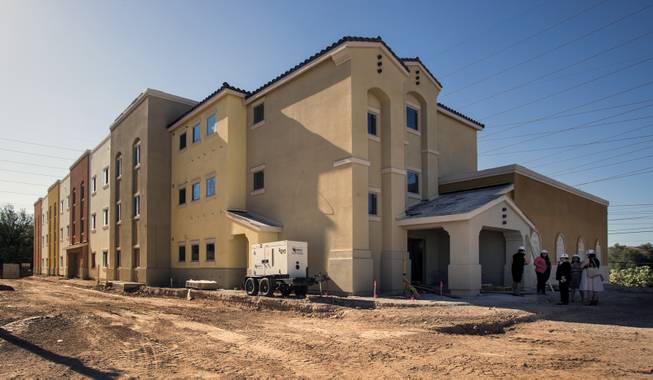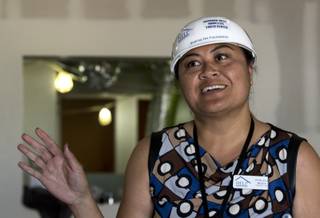
Construction continues on the new Shannon West Homeless Youth Center, with a new location and a lot more space to serve more homeless youths in Nevada, which has the highest rate in the nation of that population going without shelter.
Saturday, April 29, 2017 | 2 a.m.
Nevada has the highest rate of unsheltered homeless youth in the country, at 81.5 percent. That breaks down to 1,363 out of 1,672 unaccompanied homeless people ages 14 to 24 going without shelter. Reasons range from lack of knowledge about available services to insufficient space at existing overnight facilities.
The Silver State’s figure even beats that of states with larger populations of homeless youth, including California and New York, according to the 2016 Homeless Assessment Report to Congress. In the same year, Las Vegas ranked third in the nation for prevalence of homeless youth, with the Clark County School District reporting that during the 2015-16 school year more than 14,000 homeless students were enrolled.
The new Shannon West Homeless Youth Center, slated to open this summer, will combat the troubling reality these numbers reflect.
Located behind the main offices of parent organization HELP of Southern Nevada, on Flamingo Road near UNLV, the 37,000-square-foot center will provide services for 16- to 24-year-old Las Vegans who are homeless or at risk and with no children.
With 160 beds in 40 rooms, this facility almost doubles the bed count at the current Shannon West youth center on Foremaster Lane, a converted motel that has been operating as a shelter for nine years.
The new shelter also will add six Step Up Rooms housing one youth in a studio apartment setting to help those who’ve never lived on their own transition.
Its close proximity to HELP’s main campus will streamline the process of connecting youths to other social services. And the location is more centralized in terms of employment and educational opportunities that could help lift struggling individuals out of homelessness.
“For some youth, it’s just bad luck or it’s a bad decision — and then for others, it’s a combination of both,” Fuilala Riley, HELP’s president and CEO said.
Unaccompanied young people who experience homelessness face far more challenges than their adult counterparts. Not only do they have more difficulty finding employment, they also have a harder time accessing services, shelter and medical care, and are more at risk of falling prey to labor and sex trafficking, engaging in survival sex, and getting involved incriminal activities.
The reasons they become homeless cover a lot of ground, but Riley said the general rule is that support organizations have until they’re about 25 years old to break the cycle before homelessness is much more likely to be chronic. So HELP crafted its new facility to meet a variety of unique needs.
Each of the shelter’s three stories has a recreation room and a TV room, and those common areas will allow for events that target specific populations, whether it be those dealing with addiction or who identify on the LGBTQ spectrum.
Unlike the previous one, this facility’s cafeteria can accommodate a full house. And it was designed as a flex space that might host pop-up yoga, fundraisers or training sessions for youths interested in the culinary field.
The $10 million center represents contributions from private partners, various nonprofits and all four municipal governments within the Las Vegas Valley. While she knows the need for beds goes way beyond these 166, Riley said it’s a start. And the more youths the center can help, the more space there will be for that progress to continue.
“Homeless youths look like anyone you know,” she said. “But one thing’s certain, they don’t want to be homeless.”


Join the Discussion:
Check this out for a full explanation of our conversion to the LiveFyre commenting system and instructions on how to sign up for an account.
Full comments policy